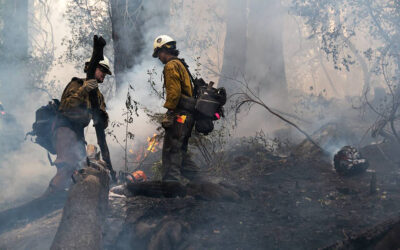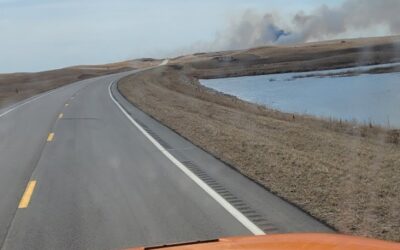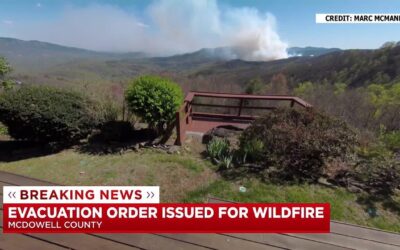BOISE, Idaho (AP) — Months after a catastrophic fire burned more than 2,200 homes in Hawaii, some property owners are getting more bad news — their property insurance won’t be renewed because their insurance company has deemed the risk too high.
It’s a problem that has played out in states across the U.S. as climate change and increasing development has raised the risks of wildfires and other natural disasters damaging communities. Insurance providers, state regulators and researchers are grappling with how to keep the insurance companies in business while keeping residents and their properties insured and protected.
“I think most of the insurers, you know, I’m very grateful that they’re committed to the Hawaii market, so we haven’t seen wholesale withdrawals,” after the Aug. 8, 2023 fire burned through Lahaina and killed 101 people, Hawaii Insurance Commissioner Gordon Ito said during a Wildfire Risk Forum for insurance commissioners held at the National Interagency Fire Center in Boise, Idaho.
But one or two insurance companies have stopped renewing policies for wood structures like townhomes that are in wildfire risk areas, Ito said Monday, in part because the companies have seen their own insurance costs climb. Property insurers typically have their own insurance coverage to help when there are big payouts, like the roughly $3 billion in claims that have been paid so far on an estimated $6 billion in damages from the Lahaina fire. But those “reinsurance” rates are climbing, Ito said, and that’s forcing some companies to reevaluate the policies they are willing to issue to residents.
The same thing happened in Colorado after the 2021 Marshall Fire destroyed 1,100 homes in Boulder County, causing an estimated $2 billion in damage, said Colorado Division of Insurance deputy commissioner Jason Lapham. Last year, Colorado lawmakers authorized the creation of the Fair Access to Insurance Requirements (FAIR) Plan, which is expected to provide bare-bones property insurance coverage for residents who can’t get insurance from a private company starting in 2025. Other states like California, Louisiana and Florida have also resorted to providing their own state-affiliated “insurers of last resort,” which can fill in the gap when when the private insurance market abandons an area because of natural disaster risk.
Insurance industry researchers say part of the solution could come from homeowners taking steps to make their properties more fire-resistant.
“This peril is a preventable peril, and it will take a will to change and do something different,” said Anne Cope, the chief engineer for the Insurance Institute for Business & Home Safety. She later demonstrated her point by taking the commissioners to two nearly identical buildings — one made out of fire-resistant materials with plenty of space between landscaping and the structure, and the other built with traditional materials and landscaping. Small fires were started next to each building, and the fire-resistant one remained mostly undamaged while the traditional building was quickly engulfed and burned to the ground.
Research shows that protecting homes from blowing embers using fire-resistant roofs and gutters and keeping the area around a home free of easily flammable material makes a big difference, Cope said.
In the early 1970s, the U.S. had more annual fire deaths than any other industrialized nation, Cope told the insurance commissioners, but a 1973 government-commissioned report on the problem called “America Burning” led to dramatic improvements, in part because of the widespread adoption of smoke detectors and building codes.
“We can do that here with suburban conflagration,” Cope said, by protecting homes from blowing embers using fire-resistant roofs and gutters and taking other basic steps like keeping defensible space around a home. Wood roofing materials are not only more statistically likely to lead to the destruction of their own building in a fire but also to the destruction of 10 other buildings nearby, she said. Juniper bushes and wooden fences and decks near homes are also likely fire entry points, as are gutters that are filled with debris.
Once one building in a community catches fire, the problem quickly compounds — while forest fires and other wildland fires generally produce small blowing embers that are quickly extinguished, structure fires create much larger embers that can be as big as a human hand, Cope said. Those big, chunky embers carry enough fuel with them to keep burning once they land on another structure, quickly setting it aflame.
The economic effects of a catastrophic fire last for years, said Ito. Insurance companies in Hawaii have already paid roughly 80% of the claims filed for personal property, nearly 100% of the claims filed for motor vehicles and about half of the commercial insurance claims, he said. Commercial insurance claims typically take longer because additional records are needed to document the losses sustained by a business.
But that’s just the recoverable losses. The economy has been devastated by the lack of tax revenue, more than 2,000 displaced residents are still living in hotels, and rebuilding hasn’t started yet, Ito said. Lahaina was a major destination for visitors, and the fires will likely lead to an ongoing reduction of about 10% or 15% in revenue for the state’s tourism industry, he said.
“And to me, the heartbreaking thing … there’s quite a few Lahaina survivors that cannot afford to stay and have chosen to leave the islands because of the lack of housing availability,” said Ito. “And so that’s, I think, the biggest impact.”




